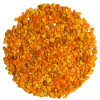
When collecting nectar, pollen grains easily stick to the hairs and the body of the insect. The bee with the help of special brushes on the paws cleans the body. It wets the collected pollen with the nectar and its own saliva and stores it in special cavities (baskets) located on the 3rd pair of legs. Pollen in the leg basket takes the form of a lump (nugget) which contains up to 5 million grains, its weight is about 20 mg. The bee delivers nugget in the hive. In one day, she can collect up to 200 mg of pollen. The bee family in one day harvests up to 1 kg of pollen, and for the whole season up to 50 kg. Pollen is the most valuable protein feed for the larvae and for the feeding bees. While eating pollen, feeding bees produce royal jelly used as food for young larvae and the queen. Bee also needs pollen to make wax.
A beekeeper can collect up to 100 g of pollen from one hive in one day, and up to 2 kg per season, which corresponds to 35-60% of the amount of pollen brought by bees to the hive. To prevent collected pollen from becoming moldy and fermented it must be dried immediately. Otherwise, it becomes toxic and unsuitable for use.
Drying pollen should be carried out for 2-3 days in a special darkened, well-ventilated dryer at an air temperature of 20-40 ° C with frequent stirring. Higher temperatures and direct sunlight reduce the quality of pollen. After drying, to remove impurities, pollen nuggets are sifted through a sieve with a hole size of 1-2 mm. Dry pollen can be preserved with powdered sugar or honey in a 1: 1 ratio and stored in sealed containers in the refrigerator. Not dried and not canned pollen, after only 7 days, loses more than half of the enzymes and vitamins. For long-term storage pollen is kept in sterilized glass jars with a tight-fitting lid.
It is important to emphasize, that in the process of making pollen, the bee adds the secret of the pharyngeal glands, containing enzymes and biologically active substances, which significantly improves its healing properties, and most importantly, reduces its allergenic properties.
Bee Bread

The pollen brought to the hive is folded into empty, mostly dark wax cells adjacent to the brood, filling them in 2/3 volume, which corresponds to 140 – 180 mg. Young bees pound the pollen in a cell with their heads, and pour honey over it. Without air and at a temperature of 33-35 ° C and high humidity in the nest, pollen is subjected to enzymatic fermentation with the formation of lactic acid. As a preservative lactic acid prevents the development of bacteria and mold fungi. The product formed from pollen is called “bee bread”.
In the process of converting pollen to “bee bread”, the following occurs in it:
- the amount of protein and fat decreases;
- the amount of carbohydrates increases;
- sucrose gradually turns into monosaccharides;
- simple sugar under the influence of enzymes is partially converted into lactic acid;
- increases the amount of some vitamins (D, E, K), growth hormones and other active substances;
- the shell of the pollen granules, is getting destroyed, which improves their utilization when used by bees and humans;
- pollen almost completely loses allergenic properties;
- value of “bee bread” as a health product is high because it contains varieties of pollen.
“Bee bread”, is very rich in vitamins (much higher than honey). It is especially rich in vitamins A (50-120 mg/100g) and E (170-300 mg/100g). This must be taken into account when prescribing the daily and course dose of “bee bread” so that the excess does not cause vitamin imbalance and intoxication.
Unlike native pollen ( or pollen nuggets), mature “bee bread” can be stored for years, almost without losing its nutritional and healing properties. There are several ways collect and save “bee bread” for future use for therapeutic purposes:
- The frame with “bee bread” is placed in the refrigerator or in a cool place and it is used together with wax as needed.
- Select a frame with a “bee bread”; using a heated knife cut cells to the base on each side of the frame, crash them and place in a pan with cold water. The wax floats, and the “bee bread” granule settle to the bottom. Then the water is drained, the “bee bread” is scattered thin and dried for several days. For preservation, the “bee bread” is mixed with honey in a 1:1 ratio, placed in an airtight jar and stored in a refrigerator.
- Honeycombs with “bee bread” are cut (broke) into pieces and 2-3 times passed through a meat grinder. The resulting “stuffing” is mixed with honey at the ratio of 100-200 g of honey per 1 kg of “bee bread”. Honey preserves “bee bread” from fermentation and increases its nutritional value. The mixture is packaged in jars, filled with honey on top, tightly sealed and placed in the refrigerator. In this form, “bee bread” retains its qualities for a long time.
